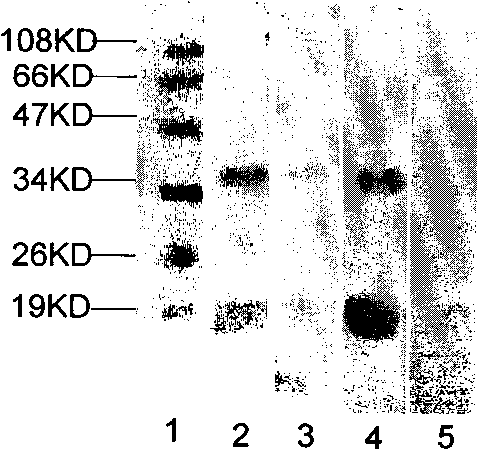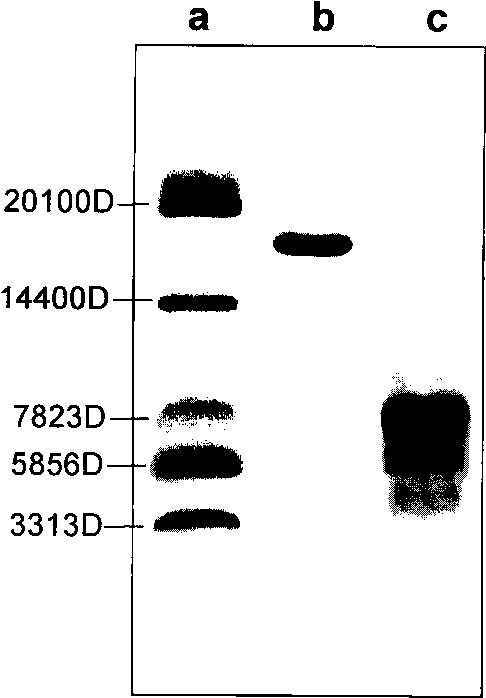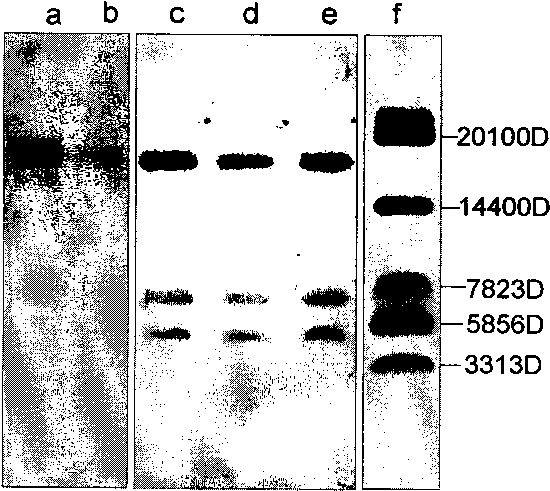Method for cutting Yersinia pestis F1 antigen and relative application thereof
A technology of F1 antigen and Yersinia pestis, which is applied in the field of analyzing the reactivity between protein A antibody-positive samples and protein A linear epitope, can solve the problems of unreasonable step distance, omission, and limited application
- Summary
- Abstract
- Description
- Claims
- Application Information
AI Technical Summary
Problems solved by technology
Method used
Image
Examples
Embodiment 1
[0055] Embodiment 1, the cleavage of F1 antigen
[0056] In this embodiment, hydroxylamine (Hydroxylamine) is mainly used as a cutting agent to cut the F1 antigen so that the linear epitopes belong to different cutting fragments.
[0057] 1. Experimental materials:
[0058] 1. F1 antigen: purchased from Qinghai Provincial Center for Disease Control and Prevention, endemic disease prevention and control, natural F1 antigen;
[0059] 2. Hydroxylamine: Fluka reagent, ~50% in H 2 O, (RT);
[0060] 3.1.5M Tris-Cl (pH9.0): Weigh 9.06 g of Tris, add 48.5 ml of double distilled water, add about 1.5 ml of 37% concentrated HCl, and adjust the pH to 9.0.
[0061]2. Experimental method:
[0062] 1. Weigh 1 mg of F1 antigen and dissolve it in 50 μl of 1.5M Tris-Cl (pH9.0);
[0063] 2. Add 50 μl of 50% hydroxylamine to the above solution containing F1 antigen, mix gently with a pipette, and be careful not to generate air bubbles;
[0064] 3. Transfer the above mixed solution into a me...
Embodiment 2
[0069] Example 2, Renaturation of F1 antigen cleavage product
[0070] This embodiment mainly removes the chemical cutting agent hydroxylamine in the cleavage product obtained in Example 1, and refolds the cleavage product. The main operations are as follows:
[0071] 1. Reagents and instruments
[0072] 1. Concentrated HCl: effective content 36% to 38%, Beijing Chemical Factory;
[0073] 2. F1 cleavage product: the product obtained in Example 1;
[0074] 3. Instruments: freeze dryer (Christ); ultra-low temperature refrigerator (-80°C);
[0075] 2. Experimental method
[0076] 1. Dispense the F1 cleavage product in 10 μl / tube;
[0077] 2. Add 100 μl of double distilled water to each tube and mix gently;
[0078] 3. Put each aliquot into a -80°C refrigerator and freeze for about 2 hours;
[0079] 4. Quickly transfer to a freeze dryer (pre-cooling for 20 minutes), freeze-drying, the temperature of the cold well is below -50°C, and the vacuum degree reaches ≤0.07mbar, and ...
Embodiment 3
[0083] Example 3, electrophoresis separation of F1 antigen cleaved fragments
[0084] In this example, Tricine-SDS-PAGE is used for small molecule electrophoresis. The gel is divided into separating gel, spacer gel and stacking gel, which are 7cm, 2cm, and 1cm respectively. The electrophoresis conditions are 60V1h, 80V4h, high ionic strength in the sample, and about 2μl The amount of sample loaded ensures electrophoretic resolution.
[0085] 1. Equipment and reagents
[0086] 1. Equipment: electrophoresis apparatus (amersham pharmacia biotech, Hoefer miniVE), image scanner (amersham pharmacia biotech, ImageScanner), decolorization shaker.
[0087] 2. Electrophoresis buffer:
[0088] Negative electrode buffer: Tricine (Solarbio): 17.92g
[0089] Tris: 12.114g
[0090] SDS: 1g
[0091] h 2 O dilute to 1000ml
[0092] Positive electrode buffer: Tris: 24.228g
[0093] Concentrated HCl: 1.5ml
[0094] h 2 O dilute to 1000ml
[0095] 3. The preparation of 49.5% (0.495T) g...
PUM
 Login to View More
Login to View More Abstract
Description
Claims
Application Information
 Login to View More
Login to View More - R&D
- Intellectual Property
- Life Sciences
- Materials
- Tech Scout
- Unparalleled Data Quality
- Higher Quality Content
- 60% Fewer Hallucinations
Browse by: Latest US Patents, China's latest patents, Technical Efficacy Thesaurus, Application Domain, Technology Topic, Popular Technical Reports.
© 2025 PatSnap. All rights reserved.Legal|Privacy policy|Modern Slavery Act Transparency Statement|Sitemap|About US| Contact US: help@patsnap.com



